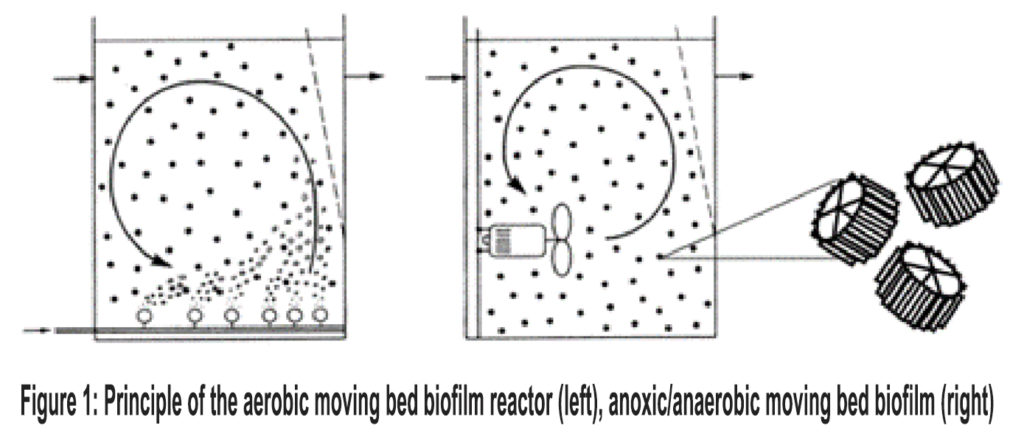
Blog
Moving Bed Biofilm Reactor (MBBR) in Wastewater Treatment
By Aoife Phillips & Maricel Pastor-Soltes – Coffey
The Moving Bed Biofilm Reactor (MBBR) is another wastewater treatment technology. The major benefit of the MBBR process is a reduced footprint – an important major advantage when faced with space constraints. The Sequencing Batch Reactor process was discussed in a previous post – this article is a continuation of our series on the various wastewater treatment technology options available to the municipal and industrial wastewater treatment industry.
The Conventional Activated Sludge (CAS) system is the most popular and widely implemented wastewater treatment system. This success can be attributed to the system flexibility in design, good effluent quality, easy to operate, very stable system, and low in cost. This somehow requires a bigger reactor volume due to the limited biomass concentration in the reactor.
In the quest to reduce the footprint of a traditional activated sludge system, many biological processes have emerged aiming to increase the biomass concentration in the reactor. The Moving Bed Biofilm Reactor (MBBR) is a wastewater treatment technology which has successfully proven its capability to improve the effluent quality and significantly reduce the footprint of a wastewater treatment plant by reducing the reactor volume and eliminating the need for a final settlement tank. However, there are several factors to be considered in using MBR system such as high capital and operational cost, membrane fouling and use of chemicals in membrane cleaning, and the requirement for a skilled operator. It is an excellent alternative where footprint and/or stringent effluent criteria is a consideration.
An alternative method to reduce reactor volume is to use biofilm to support the biomass growth. There are several known attached growth processes such as trickling filters, RBC, submerged fixed media, and fluidized bed reactors. Unfortunately, there are some known disadvantages of the attached growth systems such as blocking of the filter bed, channelling, odour issue, mechanical failure, and instability. Therefore, the process that will be focused on in this article is the moving bed biofilm configuration. The process combines the CAS and attached growth processes eliminating the problems related to channelling, clogging, and influent distribution. In the MBBR process, the media which support the growth of the biofilm are kept suspended in the reactor by aeration/mixing depending on the treatment application it is used for. The biomass is attached to the carrier media, thus, partly protected from the environment giving the system more flexibility in varying influent conditions such as pH, temperature and in the events of toxicity.

The MBBR carrier media are typically a low-density plastic media (with density slightly lower that of water) of approximately 950kg/m3 and slightly higher in the non-aerated reactors. The reactor is typically filled by media at about 50-65%. The media must be evenly distributed in the reactor and typically medium bubble diffusers are used, with the DO to be maintained between 2 –3 mg/l depending on the plant performance requirements. The outlet of the MBBR reactors need sieves/screens to hold the media within the reactors.
Moving Bed Biofilm Reactor (MBBR) is a Wastewater Treatment Technology with a degree of flexibility – MBBR can be used as the main treatment process, pre-treatment to an activated sludge process, IFAS hydrid, and post-treatment of another biological process.
Advantages of Moving Bed Biofilm Reactor (MBBR)
• Maintenance requirements – the MBBR process is low maintenance with no requirements for backwashing and minimal requirements for desludging.
• Size – A smaller MBBR can treat the same amount of water as a larger tank for a more traditional process due to the large surface area provided by the media in an MBBR. Therefore, they are an excellent option to consider for a site with limited space available.
• Highly efficient – The speed at which the MBBR can work is faster than more traditional water treatment methods, with a hydraulic retention time (HRT) for BOD and nitrogen removal of 3-4 hours.
• Flexibility – MBBR has a natural ability to adjust to changing loads and variations in the influent. It can resist shock loading and sudden pH level spikes.
• Cost Effective – Addition/retrofit of an MBBR in existing plants that are overloaded, or experience population increases can be a cost-effective method and high efficiency method of improving plant performance and is an excellent alternative to building an entirely new treatment plant.
• Operation – due to the nature of the process and its low maintenance requirements, the MBBR is easy to operate. The system is self-moderating and automatically responds to changes which means adjustments from the operator are rarely necessary.
Use of MBBR in Industry
MBBR has proven to be a highly versatile wastewater treatment process in a variety of industries – some examples of where the technology is used include:
• Wastewater from the textile industry contains pollutants such as dyes and wetting agents. Generally, the treatment of Wastewater from the textile industry which contains pollutants such as dyes and wetting agents, involves a chemical treatment stage followed by a biological treatment stage. MBBR is a highly effective biological treatment for this industry and the compact nature makes it an excellent option for smaller textile factories.
• The food industry and in particular dairy processing, which produces a large volume of wastewater containing BOD. Due to the high efficiency of MBBR, it is ideally equipped to handle the large amounts of effluent produced.
• MBBR is also used in the treatment of water from pulp and paper manufacturing, chemicals manufacturing, and beverage manufacturing.
Coftec are specialists in water treatment and we design bespoke wastewater treatment solutions that are adapted to local conditions, meet health standards and protect water resources and biodiversity. Our multi-disciplinary team of engineers and experts offer a proven track record of leveraging their expertise and experience in providing the most practical solutions to treat wastewater.
Contact Coftec whether designing a new facility or refurbishing, expanding, or bringing an existing facility up to regulatory standards to discuss how we our expertise of MMBR and other wastewater treatment technologies can help in your project.
To know more, contact us at info@coftec.ie, call us on +353 (0)91 844356 or submit your inquiry via our contact form.




